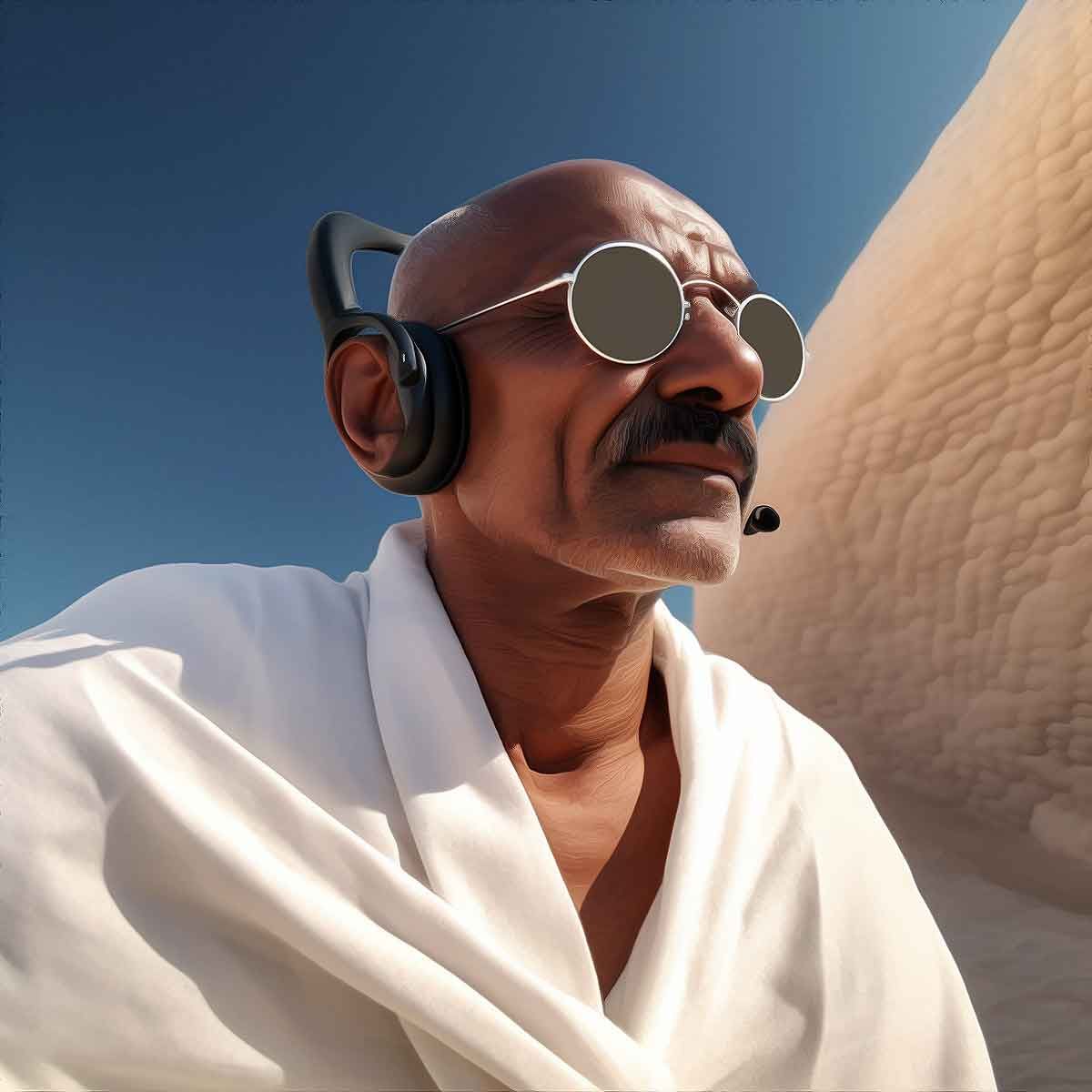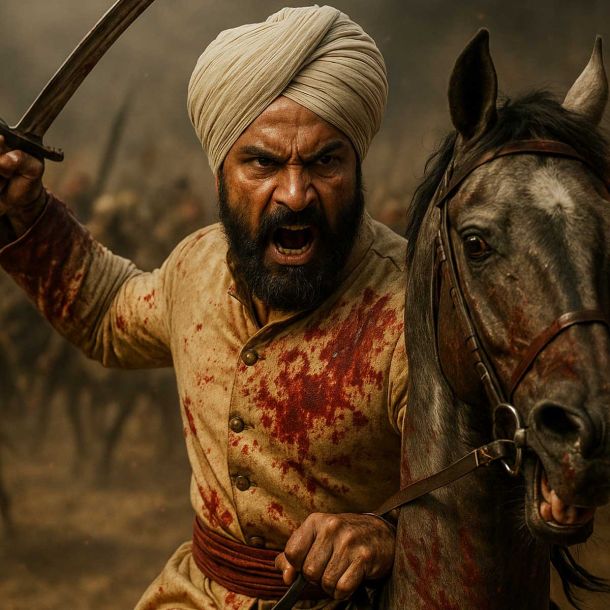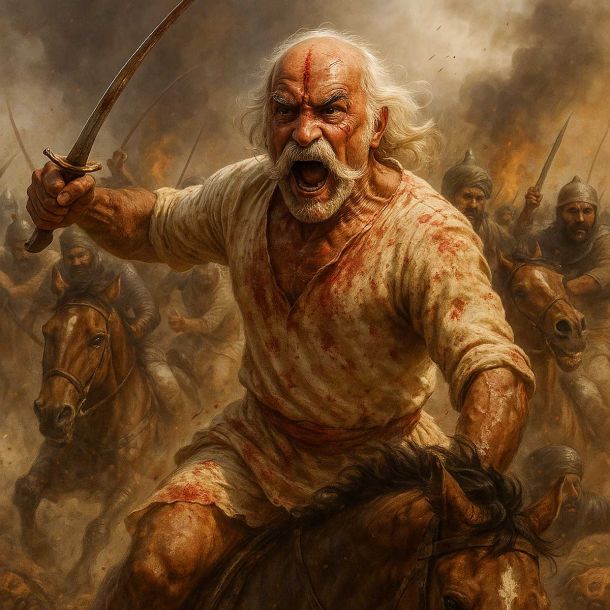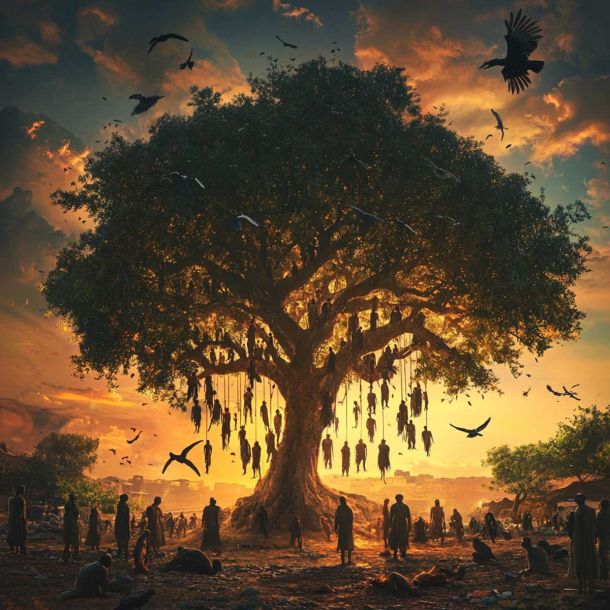Sanatan Articles
Satyaagrah
Written on
Satyaagrah
Written on
Satyaagrah
Written on
Satyaagrah
Written on
Satyaagrah
Written on
JOIN SATYAAGRAH SOCIAL MEDIA
"Each betrayal begins with trust": "Raghupati Raghava Raja Ram" that was atrociously distorted by Gandhi into a fake pseudo secular anthem was actually inspired from "Nama Ramayanam", a short Ramayana composed by Sri Lakshmanacharya

In the annals of Indian history, the devotional hymn 'Raghupati Raghav Raja Ram' resonates as a symbol of our freedom struggle, its melody echoing the spirit of unity and peace. This sacred chant, also known as Ram Dhun, is not merely a song but a testament to the profound devotion of Shri Lakshmanacharya, a poet and ardent devoteer of Lord Vishnu. However, the version that has been etched into our collective consciousness is not the original one, but a rendition popularised by Mahatma Gandhi.
|
Mahatma Gandhi, revered as the 'Father of the Nation' in India, hailed from a Gujarati Hindu Modh Bania family in the coastal town of Porbandar. After completing his education in England, he traveled to South Africa to practice law.
Upon his return to India, he became a key figure in the fight for independence from Britain's oppressive rule. Among his various strategies, he orchestrated daily prayer meetings designed to foster reconciliation between divided communities, primarily Hindus and Muslims. These gatherings featured communal singing of popular bhajans and religious hymns, with Gandhi often exploring the meanings and messages within their lyrics.
One contentious point arises from Gandhi's alterations to the lyrics of a Hindu religious bhajan, "Raghupati Raghav Raja Ram," seen by some as a betrayal in an effort to pacify Muslims. This hymn was first sung in Gandhi-led assemblies during his historical 241-mile Dandi March in 1930. The march was a nonviolent protest against a newly enacted British law prohibiting Indians from producing or selling salt. The hymn became an emblem of resilience for the marchers.
However, contrary to popular belief, Gandhi did not compose the hymn but adapted it. The original lyrics were sourced from Shri Nama Ramayanan, an ancient religious text authored by Sri Lakshmanacharya. As the hymn's popularity grew, a widespread misconception emerged that it was a patriotic song, symbolizing a secular and unified Indian society. But the original composition, often referred to as Ram Dhun, was more accurately a tribute extolling Lord Ram. Gandhi's alterations were seen by some as a manipulation of its original intent, causing a sense of betrayal amongst those who revered the original hymn.
However, this version was not entirely faithful to the original. In his quest to promote a false notion of secularism, Gandhi introduced the word 'Allah' into the hymn, a modification that has since become a point of contention.
The original hymn, excerpted from Shri Nama Ramayan, is a beautiful ode to Lord Rama, extolling his virtues and recounting the epic tales from the Ramayana. The original lyrics in Hindi are as follows:
रघुपति राघव राजाराम पतित पावन सीताराम ॥
सुंदर विग्रह मेघश्याम गंगा तुलसी शालग्राम ॥
भद्रगिरीश्वर सीताराम भगत-जनप्रिय सीताराम ॥
जानकीरमणा सीताराम जयजय राघव सीताराम ॥
रघुपति राघव राजाराम पतित पावन सीताराम ॥
रघुपति राघव राजाराम पतित पावन सीताराम ॥
This version, unlike the one popularised by Gandhi, does not include the word 'Allah'. It is a hymn in its purest form, untainted by political ideologies or attempts at appeasement. It is a hymn that speaks of divine love, devotion, and the eternal virtues of Lord Rama. It is a hymn that deserves to be acknowledged and preserved in its original form.
In the year 1948, a significant film titled "Shri Ram Bhakt Hanuman" graced the Indian cinema. This film, as the title suggests, was a tribute to the unwavering devotion of Hanuman, the monkey god, towards Lord Rama, a central figure in Hindu mythology. The narrative of the film was deeply rooted in the spiritual and devotional aspects of Hinduism.
One of the highlights of the film was the inclusion of the original form of the hymn "Raghupati Raghav Raja Ram," a devotional song in praise of Lord Rama. The hymn, as presented in the film, adhered strictly to its original composition, maintaining the integrity of its spiritual message and its cultural significance.
Interestingly, the word "Allah" does not appear anywhere in the hymn as presented in the film. This is noteworthy because the word "Allah" is not part of the original hymn, and its inclusion would have been a deviation from the traditional Hindu context in which the hymn was created. The hymn, in its original form, is a pure expression of devotion to Lord Rama and does not incorporate elements from other religious traditions.
Therefore, the absence of the word "Allah" in the hymn as presented in the film "Shri Ram Bhakt Hanuman" is not only accurate but also respectful of the hymn's original context and the religious sentiments it embodies. The film, in adhering to the original composition of the hymn, preserved its authenticity and upheld the sanctity of the religious traditions it represents.
|
Gandhi’s version, which was mainstreamed by him and his supporters during the Dandi march and later during his prayer meetings, runs:
Raghupati Raghava Rajaram,
Patita paavana sitaram,
bhaj pyaare tu sitaram
Ishwar Allah Tero Naam,
sabko sanmati de bhagwan.
Shri Lakshmanacharya, a poet and Vishnu devotee, is a significant figure in the realm of devotional literature. He is most renowned for his composition of the 'Ram Dhun,' also known as 'Raghupati Raghav Raja Ram,' a bhajan (devotional song) that has been widely popularised by Mahatma Gandhi. This hymn is a part of the 'Shri Nama Ramayan,' a revered Hindu text that Lakshmanacharya authored.
Unfortunately, detailed information about Shri Lakshmanacharya's life and other works is sparse. His primary claim to fame remains the 'Shri Nama Ramayan,' a text that encapsulates the epic tale of Lord Rama in a devotional format. The 'Ram Dhun' is a significant part of this text, and its popularity has transcended the boundaries of religion and culture, largely due to its association with India's freedom struggle.
The 'Ram Dhun' is a hymn in praise of Lord Rama, illustrating his qualities by citing various incidents from the Ramayana. It is a testament to Lakshmanacharya's deep devotion to Lord Vishnu, of whom Rama is an avatar, and his skill as a poet. The hymn's profound spiritual message and its melodious tune have made it a staple in devotional gatherings across India.
Despite the lack of extensive information about his other works, it is clear that Shri Lakshmanacharya's contribution to devotional literature, particularly through the 'Shri Nama Ramayan,' has had a lasting impact. His work continues to inspire and guide devotees in their spiritual journey, underscoring the timeless relevance of his writings.
It is important to continue researching and uncovering more about Shri Lakshmanacharya's life and works to fully appreciate his contributions to devotional literature and the rich cultural heritage of India.
Mahatma Gandhi, revered as the Father of the Nation in India, was a masterful communicator who understood the power of symbols, songs, and phrases in shaping public sentiment and mobilizing masses. He often adapted traditional songs and phrases to fit his ideology and the principles he stood for, such as non-violence, truth, and religious harmony. However, some critics argue that this adaptation sometimes amounted to manipulation, as it altered the original context and meaning of these songs and phrases.
One of the most notable examples is the devotional song "Raghupati Raghav Raja Ram," originally composed by Shri Lakshmanacharya. Gandhi popularized this song during the Indian freedom struggle, but he added the line "Ishwar Allah Tero Naam" to promote his vision of religious harmony. Critics argue that this was a manipulation that distorted the original Hindu devotional song to appease the Muslim community.
The widespread popularity of this manipulated version of the religious hymn was fueled both by Gandhi's promotion and its inherently secular interpretation. The hymn was set to music by the eminent musicologist Pandit Vishnu Digambar Paluskar, priming it for public consumption and subsequently boosting its popularity.
The film industry, too, played a role in perpetuating this distorted rendition of the hymn. Notably, Hindi films such as 'Lage Raho Munnabhai' and 'Kuch Kuch Hota Hai' featured the Gandhi-adapted version of the devotional song. Moreover, it was the opening track on the Afrobeat band’s album 'Osibisa – Unleashed – Live' in 1982.
With the lyrics doctored in this way, Muslims would have faced little to no difficulty in aligning with Gandhi and participating in his prayer meetings. These gatherings were intended to bridge the gap between Hindus and Muslims and foster communal harmony. Yet, it invariably fell upon the Hindu majority to appease the Muslim minority's sensitivities, while expecting no reciprocation.
Gandhi's readiness to warp the lyrics of a Hindu religious hymn to assuage Muslim apprehensions is a striking illustration of this one-sided dynamic. However, not once did he voice disapproval for verses in the Holy Quran that decry idol-worship as sinful and prescribe severe punishment for idolaters, despite his fervor for mutual respect and understanding among religious communities. His selective application of principles sparked a sense of betrayal and elicited deep-seated disgust in those who held the original hymn in high esteem.
Gandhi manipulated the lyrics of the hymn, twisting it into an unrecognizable version, all in a bid to placate the Muslim community. They might have otherwise resisted its recitation at prayer meetings, given that the hymn venerates Lord Ram, which contradicts the Islamic monotheistic doctrine.
Remarkably, Gandhi's interfaith prayer rituals even incorporated the recitation of the Islamic Kalma. However, no historical records or reports suggest that Gandhi ever altered Quranic verses or modified the Muslim Kalma to address Hindu concerns or to align with his professed ideals of mutual coexistence and communal harmony. This glaring double standard likely contributed to the growing polarization of Gandhi's prayer meetings in the lead-up to the Partition, as doubts were cast on his wisdom in including the Muslim Kalma during these gatherings.
Ahimsa Paramo Dharma – Gandhi’s Half Truth
Gandhi's use of the phrase "Ahimsa Paramo Dharma" is another point of contention. The complete phrase is "Ahimsa Paramo Dharma, Dharma himsa tathaiva cha," which translates to "Non-violence is the ultimate duty, but so is violence in the service of Dharma." Gandhi often quoted only the first half of this phrase, emphasizing non-violence while omitting the context provided by the second half.
These examples have led some critics to argue that Gandhi manipulated Hindu songs and phrases to fit his ideology, sometimes at the expense of their original meanings and contexts. They contend that these manipulations were part of a broader pattern of Gandhi prioritizing communal harmony and non-violence over the interests and beliefs of the Hindu community.
The phrase in Sanskrit, largely brought into global recognition by Mahatma Gandhi as an assertion of non-violence, is quite prevalent worldwide today. Its origin traces back to the epic narrative of the Mahabharata and, when translated, it communicates a profound message - "non-violence is the highest duty," so high that it surpasses all other duties.
This principle, when adhered to by an individual, implies that there is no room for selective application of the practice of ahimsa, or non-violence. It necessitates that the principle be incorporated into all aspects of life, promoting an unwavering and unilateral renunciation of violent resistance under any given circumstances. Nonetheless, this interpretation holds true primarily within the philosophical bounds and among the devoted followers of Buddhism and Jainism.
Interestingly, many of us, familiar with the phrase, might not fully comprehend that what we often quote is merely a part of the full teaching. The complete phrase in the Mahabharata reads:
अहिंसा परमो धर्मः ध
र्म हिंसा तथैव च
"Non-violence is the supreme dharma. So too is violence when it is in the service of Dharma."
According to Sanatana Dharma, the initial part of the saying is exclusively pertinent to the renunciates and the ascetics. A Sannyasin, even under provocation, should refrain from defending himself, even if his life is under threat, because his identification is with the Atman (soul or spirit), rather than with his physical form.
Intriguingly, it is the latter part of the phrase, a crucial piece of the complete teaching, that is often omitted by those advocating Dharma and Ahimsa. The significance of this part of the message asserts that violence can also serve Dharma, emphasizing the complex and multifaceted nature of these spiritual teachings.
The term 'non-violence' as used in English carries an absolute interpretation, indicating an unwavering and all-encompassing absence of violence. However, the concept of 'ahimsa' in Sanatana Dharma, while typically translated to non-violence, actually carries a more nuanced, relative meaning. It suggests that in some circumstances, resorting to violence may be a moral obligation, particularly if such action serves to prevent a more substantial act of violence or a greater evil from unfolding. For instance, a king might need to enforce strict punishments to maintain peace and order within his realm. In practicing ahimsa, the king may even be required to take the life of a man who, for example, is jeopardizing the lives of others.
Therefore, when the teaching of ahimsa is fully appreciated within the context of Sanatana Dharma, it becomes applicable and relatable to the majority of people.
In ancient times, societal roles and duties were clearly defined. The Brahmins, for instance, were entrusted with the responsibility of being well-versed in spiritual matters and practicing benevolence towards all creatures. On the other hand, the Kshatriyas were designated as the protectors of everything, including Dharma.
This is reflected in the Adi Parva, where it states:
अहिंसा परमॊ धर्मः सर्वप्राणभृतां समृतः तस्मात पराणभृतः सर्वान न हिंस्याथ बराह्मणः कव चित
"Indeed, the supreme virtue of a human is to spare the lives of others. Therefore, a Brahmana should never inflict harm upon any creature."
बराह्मणः सौम्य एवेह जायतेति परा शरुतिः वेथवेथाङ्गवित तात सर्वभूताभय परथः
"A Brahmana should be knowledgeable in the Vedas and Vedangas and should instill faith in all beings towards God."
अहिंसा सत्यवचनं कषमा चेति विनिश्चितम बराह्मणस्य परॊ धर्मॊ वेथानां धरणाथ अपि
"Ahimsa, truthfulness, and forbearance are unequivocally affirmed. These are the highest duties of a Brahmana, even beyond the adherence to the Vedas."
The Brahmin's responsibilities are clearly stated - he should show kindness to all creatures, speak the truth, forgive, and above all, it is his supreme duty to retain the teachings of the Vedas in his memory.
In contrast, the duties that fall to the Kshatriya are different. Sternness, the wielding of authority, and the proper rule over their subjects are the primary responsibilities of a Kshatriya. To put it briefly, the text asserts that while a Brahmin should never take the life of any creature, a Kshatriya might have to do so if required to uphold law and order.
In the Vana Parva, Markandya Muni narrates:
काललॊभ गरहाकीर्णां पञ्चेन्थ्रिय जलां नथीम
नावं धृतिमयीं कृत्वा जन्म थुर्गाणि संतर
करमेण संचितॊ धर्मॊ बुथ्धियॊगमयॊ महान
शिष्टाचारे भवेत साधू रागः शुक्लेव वाससि
This passage emphasizes that virtuous men always exhibit kindness towards all beings, particularly towards those of spiritual inclinations. They refrain from causing harm to any creature and never resort to rude or harsh language. Such good men, who have a deep understanding of the results of their virtuous and sinful deeds, are held in high regard by others leading a virtuous life.
In this context, "ahimsa" is used to underscore the principle of non-injury to any creature, particularly as practiced by spiritually inclined or holy men.
Contrary to common belief, this specific phrase does not appear in the Bhagavad Gita. Instead, Lord Krishna exhorts Arjuna to rise and engage in battle, emphasizing the necessity of fulfilling one's duty, even when it involves violence:
अथ चेत्त्वमिमं धर्म्यं संग्रामं न करिष्यसि
ततः स्वधर्मं कीर्तिं च हित्वा पापमवाप्स्यसि
"If you refuse to fight in this righteous war, then refusing to do your duty, you will lose your reputation and thus you will incur sin."
Indeed, if you shirk from this righteous war, you will be guilty of neglecting your duty, and thus lose your reputation as a warrior.
In these circumstances, the duty of a man extends to combating injustice and evil, even if it entails setting aside the overarching principle of non-violence. Lord Krishna explicitly communicates that while ahimsa is respected, it is not the supreme dharma for everyone, and most certainly not for Arjuna on the battlefield of Kurukshetra.
When a person renounces the trappings of sensory objects and the sense of doership in actions, instead focusing on the inner self or Atman in pursuit of knowledge (Jnana) and liberation (Moksha), they are then truly walking the path of Ahimsa.
However, for a householder immersed in worldly pursuits, the strict adherence to ahimsa can be impractical. For instance, if someone trespasses into a house and threatens the safety of a householder's family, practicing ahimsa in such a situation would be tantamount to cowardice. Similarly, a soldier cannot lay down his arms in the midst of a war; neither can a king permit criminals or hostile neighboring kingdoms to continue their transgressions against his subjects under the guise of non-violence.
In these situations, practicing ahimsa would amount to a dereliction of duty, an adharma, not Dharma!
This sentiment is echoed in the words of Lord Krishna:
परित्राणाय साधूनां विनाशाय च दुष्कृताम्
धर्मसंस्थापनार्थाय सम्भवामि युगे युगे
"For the protection of the virtuous, for the destruction of evil-doers, and for establishing righteousness on a firm footing, I am born from age to age." Here, Lord Krishna proclaims his recurring manifestations, underlining the necessity of active intervention when righteousness is under threat, even if it involves using force against wrongdoers.
 Support Us
Support Us
Satyagraha was born from the heart of our land, with an undying aim to unveil the true essence of Bharat. It seeks to illuminate the hidden tales of our valiant freedom fighters and the rich chronicles that haven't yet sung their complete melody in the mainstream.
While platforms like NDTV and 'The Wire' effortlessly garner funds under the banner of safeguarding democracy, we at Satyagraha walk a different path. Our strength and resonance come from you. In this journey to weave a stronger Bharat, every little contribution amplifies our voice. Let's come together, contribute as you can, and champion the true spirit of our nation.
 |  |  |
| ICICI Bank of Satyaagrah | Razorpay Bank of Satyaagrah | PayPal Bank of Satyaagrah - For International Payments |
If all above doesn't work, then try the LINK below:
Please share the article on other platforms
DISCLAIMER: The author is solely responsible for the views expressed in this article. The author carries the responsibility for citing and/or licensing of images utilized within the text. The website also frequently uses non-commercial images for representational purposes only in line with the article. We are not responsible for the authenticity of such images. If some images have a copyright issue, we request the person/entity to contact us at This email address is being protected from spambots. You need JavaScript enabled to view it. and we will take the necessary actions to resolve the issue.
Related Articles
- During Partition Hindu and Sikh refugees concentrated in Delhi to a humiliating and dehumanizing experience whereas Muslim were being provided with rations, funds, jobs and shelter: MK Pahwa try to assassinate Gandhi
- When Secular Nehru Opposed Restoration Of Somnath Temple - The Somnath Temple treachery
- If not for Muslim appeasement, Vande Mataram would have been India's National Anthem: the history of Muslim opposition and support
- The untold story of Maharashtrian Brahmin genocide committed by Congress after Gandhi’s assassination in 1948
- British author Tunku Varadarajan tried to tarnish the image of iconic freedom fighter Netaji with reference to Hitler: Sinister agenda to malign the legacy of Netaji from calling him a ‘flawed hero’ to a ‘Nazi sympathiser’
- If only India’s partition chilling wound was not enough, Gandhi did his last protest again only to blackmail India into giving 55 crores to Pakistan, dragged Hindu, Sikh refugees seeking shelter in mosques to die in cold: And we call him Mahatma, not for
- Harmonizing Nathuram Godse: Why India should move beyond denouncing him, a man who altered the course of not only the politics of the country but the very history of the Hindu Civilisation and, by extension, the world at large
- The first large-scale massacre in Independent India accounts for one of the biggest coverups in modern history: It is about time we talk about the 1948 genocide of Maharashtrian Brahmins following MK Gandhi’s assassination
- Gandhi emphasized that he won't salute Indian National Flag if Charkha is replaced by Ashoka Chakra and wanted British flag added to it
- Father of the Nation! Absolutely not. Mohandas Karamchand Gandhi was not the father of the nation either officially or otherwise
- Netaji, an Impossible man can never be boxed into an ideological corner: Not just the most enigmatic figure in world history but his life is also a tough lesson in how to think about history
- Winning wars but losing the peace: Sri Krishna and Mahatma
- Ghost from the past: Unseen picture of Nehru voting in favour of partition of India goes viral
- Indian state bans book on Mahatama Gandhi after reviews hint at his gay relationship
- A Great man Beyond Criticism - Martyrdom of Shaheed Bhagat Singh (Some Hidden Facts)





















